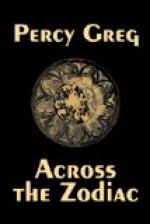“Oh yes!” she answered. “Nearly all our domestic animals will do anything they are told which lies within their power. You have seen the tyree marching in a line across a field to pick up every single worm or insect, or egg of such, within the whole space over which they move, and I think you saw the ambau gathering fruit. It is not very usual to employ the latter for this purpose, except in the trees. Have you not seen a big creature—I should call it a bird, but a bird that cannot fly, and is covered with coarse hair instead of feathers? It is about as tall as myself, but with a neck half as long as its body, and a very sharp powerful beak; and four of these carvee would clear a field the size of our garden (some 160 acres) of weeds in a couple of days. We can send them, moreover, with orders to fetch a certain number of any particular fruit or plant, and they scarcely ever forget or blunder. Some of them, of course, are cleverer than others. The cleverest will remember the name of every plant in the garden, and will, perhaps, bring four or even six different kinds at a time; but generally we show them a leaf of the plant we want, or point out to them the bed where it is to be found, and do not trouble their memory with more than two different orders at a time. The Unicorns, as you call them, come regularly to be milked at sunset, and, if told beforehand, will come an hour earlier or later to any place pointed out to them. There were many beasts of burden before the electric carriages were invented, so intelligent that I have heard the rider never troubled himself to guide them except when he changed his purpose, or came to a road they had not traversed before. He would simply tell them where to go, and they would carry him safely. The only creature now kept for this purpose is the largest of our birds (the caldecta), about six feet long from head to tail, and with wings measuring thrice as much from tip to tip. They will sail through the air and carry their rider up to places otherwise inaccessible. But they are little used except by the hunters, partly because the danger is thought too great, partly because they cannot rise more than about 4000 feet from the sea-level with a rider, and within that height there are few places worth reaching that cannot be reached more safely. People used to harness them to balloons till we found means to drive these by electricity—the last great invention in the way of locomotion, which I think was completed within my grandfather’s memory.”
“And,” I asked, “have you no animals employed in actually cultivating the soil?”
“No,” she replied, “except the weeding birds of whom I have told you. When we have a piece of ground too small for our electric ploughs, we sometimes set them to break it up, and they certainly reduce the soil to a powder much finer than that produced by the machine.”
“I should like to see those machines at work.”
“Well,” answered Eveena, “I have no doubt we shall pass more than one of them on our way.”




